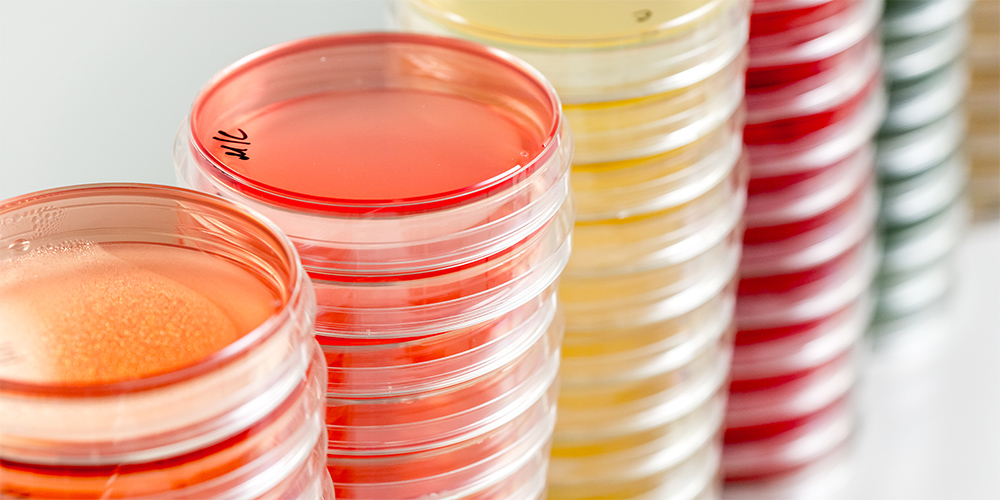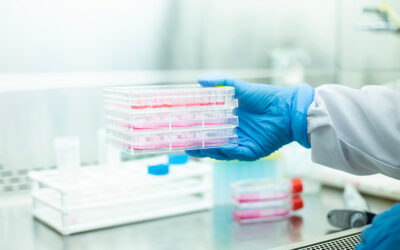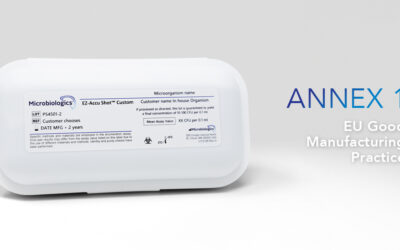The U.S. Pharmacopeia (USP) created quite the challenge when it designed the growth promotion test (GPT) for selective media. Laboratories not only need to test new batches of media with less than 100 colony-forming units (CFU), the colonies must also grow on agars such as MacConkey within 18 hours. We’ve compiled nine best practices to help you become a selective media GPT expert.
1. Don’t expect a microorganism to grow as well on selective agar as on non-selective agar (even if the non-selective agar was designed for the microorganism species)
For example, the crystal violet and bile salts in MacConkey Agar inhibit Gram-positive microorganisms while allowing many types of Gram-negative microorganisms to grow. Just because the MacConkey Agar allows Gram-negative strains to grow, it doesn’t mean they will flourish.
For instance, if Tryptic Soy Agar (TSA) and MacConkey Agar are tested in parallel from an Escherichia coli suspension containing ≤100 CFU per inoculum, the E. coli will usually recover more colonies the nutrient-rich TSA than on MacConkey. From the E. coli’s viewpoint, growing on TSA is like eating a well-balanced diet containing plenty of fruits and vegetables, whereas growing on MacConkey is like eating nothing but potato chips.
Keep in mind there is no requirement for what percent recovery there must be on selective agar versus non-selective agar, so there is no need to fret if you don’t get even 50% recovery.
2. Don’t worry about the factor of two
The factor of two shouldn’t be on your mind when testing the growth-promoting properties of selective media because it isn’t a requirement according to the USP. Instead, the USP states growth on the new batch of selective media should be “comparable” to growth on the previously approved batch of selective media.
3. Confirm the number of CFU in your inoculum on non-selective agar
What if you recover no colonies when you inoculate MacConkey Agar with E. coli? Does this mean the MacConkey Agar is unacceptable or that you have no E. coli in your inoculum? If you test a non-selective agar such as TSA in parallel with the selective agar, you can confirm whether there were viable E. coli cells in the inoculum. Remember, as mentioned above, there is no requirement for what percent recovery must be achieved when comparing non-selective to selective recovery.
4. Incubate plates in stacks of four or less
The USP puts a time limit on how many hours you can incubate your new batch of selective media before seeing growth. For example, colonies of E. coli should appear on VRBG agar within 18 hours of placing the plates in the incubator.
Eighteen hours is not much time! One way to ensure the bacteria can meet this strict deadline is to stack agar plates only four plates high. An incubator full of tall stacks of agar plates takes longer to warm up than an incubator with small stacks, and the plates in the middle of the stacks will also take longer to warm up. The agar plates need to reach 30˚C to 35˚C quickly to give the bacteria enough time to grow.
5. Use more CFU
If you inoculate your agar with <10 CFU, it is possible you will get no growth when using media that is very selective.
If the mean assay value of your inoculum is less than 50 CFU per 0.1 ml on non-selective media, you can try doubling the inoculum to improve your chances of recovery on selective media. For example, if the mean assay value is 30 CFU per 0.1 ml on TSA, you can inoculate a new batch of MacConkey agar with 0.2 ml and still be under the USP limit of ≤100 CFU.
6. Use the environmental conditions required by the species
- Remember fungus prefers cooler temperatures. USP <62> recommends growing Candida albicans and Aspergillus brasiliensis at 20-25˚.
- Use an anaerobic indicator when growing anaerobes such as Clostridium sporogenes.
- Check and record incubator temperatures twice a day.
- Validate incubators and calibrate thermometers on a routine basis.
- Validate incubators to ensure they stay in correct temperature range. Beware of hot spots in your incubator.
7. Use high-quality media
Results can vary with the type of media used. We have seen this when testing Pseudomonas aeruginosa on TSA. Below are our results when we inoculated six brands of media with 0.1 ml from the same suspension of P. aeruginosa.
| Tryptic Soy Agar | CFU per ml |
| Brand A | 36 |
| Brand B | 45 |
| Brand C | 57 |
| Brand D | 38 |
| Brand E | 21 |
| Brand F | 10 |
8. Give pour plates more time to grow
Colonies often grow more slowly on pour plates compared to spread plates. For instance, you may need to incubate pour plates an extra 24 hours before you can see tiny Staphylococcus aureus colonies. A background light can help you spot them.
9. Use a standardized inoculum
By using a standardized inoculum of 10-100 CFU, you can avoid the unpleasant surprise of finding 120 colonies on your agar plate the day after you inoculated it with the suspension prepared with a turbidimeter.
Using standardized suspensions also saves time. Michael Sinclair from the Microcheck Microbial Analysis Laboratory performed a time study that compared the time it takes to perform the growth promotion test using commercially-prepared microorganisms versus traditionally-prepared microorganisms. The study found that the total hands-on- time (HOT) for traditional spectrophotometric and turbidimetric methods was 115 minutes for five microorganisms, whereas the total HOT time for methods using commercially prepared microorganisms was only 30 minutes for five microorganisms.
Microbiologics offers a broad collection of QC microorganism products for performing the growth promotion test on selective media. EZ-Accu Shot™, EZ-Accu Shot™ Select, EZ-CFU™ and EZ-CFU™ One Step are designed to make the test hassle-free. All four products deliver 10-100 CFU per 0.1 ml.
About the Authors
 Karla I. Fjeld is the Research and Development Scientist at Microbiologics. Karla received a Bachelor of Arts in biology and chemistry at the College of St. Benedict, St. Joseph, Minnesota in 2001, and a PhD in biochemistry and molecular biology at Michigan State University, East Lansing, Michigan in 2007. As the R&D Scientist, she works on both new products and product and process improvements.
Karla I. Fjeld is the Research and Development Scientist at Microbiologics. Karla received a Bachelor of Arts in biology and chemistry at the College of St. Benedict, St. Joseph, Minnesota in 2001, and a PhD in biochemistry and molecular biology at Michigan State University, East Lansing, Michigan in 2007. As the R&D Scientist, she works on both new products and product and process improvements.
 Laurie Kundrat, MT (ASCP) has over 25 years of experience as a Microbiologist and a Clinical Technologist. Laurie is an active member of the Personal Care Products Council (PCPC) and serves as a member of the Microbiology Committee. She graduated from Case Western Reserve University with a degree in Biology. She also earned a Medical Technology degree from Fairview General Hospital.
Laurie Kundrat, MT (ASCP) has over 25 years of experience as a Microbiologist and a Clinical Technologist. Laurie is an active member of the Personal Care Products Council (PCPC) and serves as a member of the Microbiology Committee. She graduated from Case Western Reserve University with a degree in Biology. She also earned a Medical Technology degree from Fairview General Hospital.






Thanks for this information
Thanks for sharing knowledge .
Important points to remember during GPT
I gain fundamental knowledge
Thank you for the impart! really appreciate
Good information to consider when doing GPT!
Thanks for sharing knowledge ?
Is anyone enriching the organisms first? Or using it straight from microbiologic vial?
Kathy – Generally, Growth Promotion Testing is conducted directly on the agar plates and/or in the broth bags (or tubes) prior to their use in the laboratory. One could also inoculate the pre-enrichment and enrichment broths (using the Microbiologics GPT products) and then process them in parallel with your daily samples. This would serve as a means of performing quality control on your entire pre-enrichment, enrichment and detection system, whether the detection system be molecular or culture based.
Would anyone happen to have the usp reference that states that selective media doesn’t have to follow the factor of 2? I haven’t been able to find anything conclusive.
Hello:
i have a question regarding Molds growth promotion. How do i get a count of less than 80 for molds (fungi) after i have serial diluted. please answer. Thanks
Hello Arun – If you are using a non-enumerated product, you will have to plate each serial dilutions to determine which dilution will be at the desired concentration. Our Dilutions Guide and How to Perform Serial Dilutions in Microbiology video are helpful resources.
If you’re looking for an easier way to perform your test, you may be interested in using one of our enumerated products like EZ-Accu Shot™. This product line includes 0392A Aspergillus brasiliensis derived from ATCC® 16404™ which is already enumerated and will offer 10-100 CFU/0.1 ml. You can learn more about EZ-Accu Shot on our website where you can find all the strains available and our Instructions for Use.
Anybody can explain,
Whenever i spread less ≤ 100 CFU on the surface of selective media (like MCA, MSA, XLDA) , there were no recovery observed in the plate , but same inoculum show growth when spread on non-selective agar media ( like SCDA ).
Is spread plate method is acceptable for slective media (like MCA, MSA, XLDA)?
can we use streaking on the surface of slective media as selective media use only or qualitative analysis?
Kindly help
Dear Sir, kindly explain :
Whenever i spread less ≤ 100 CFU on the surface of selective media (like MSA , MCA, XLDA, there were no recovery observed in the plate , but same inoculum show growth when spread on non-selective agar media ( like SCDA). Does it happen with everyone or this is happening to me only.
Can we use streaking on the selective media under GPT test as selective media use only for qualitative analysis?
kindly help.
Naresh
nareshchand02@gmail.com
8198033938
Naresh – It is not just you. It is common to recover fewer CFU on selective media than on non-selective media since selective media often contains inhibitory substances. The USP does not expect you to use quantitative analysis for selective media. Below is one of the answers found in the USP FAQs: <62> Microbial Enumeration of Nonsterile Products: Tests for Specified Microorganisms.
Question 7.
“What are the specifications when we compare a fresh batch with a previous batch for growth promotion properties? Do we need to take a factor of 2 into account?”
“No strict requirement was deliberately given in this chapter because the test is qualitative, not quantitative. You can define the comparability criterion yourself. For example, colony size at the shortest incubation time prescribed.”
As for your question on streaking, if you mean streaking with one or more colonies, you shouldn’t do it if you follow USP standards. USP <62> says to inoculate the selective media with an inoculum less than or equal to 100 CFU. In order to determine if your inoculum contains viable microorganisms, use Tryptic Soy Agar (TSA) as a control. Test the TSA in parallel with the selective agar. The number of colonies on the TSA in the CFU value of your inoculum.
It may be difficult to recover small numbers of P. aeruginosa from some brands of Cetrimide Agar. For this media you may want to try using a heavier inoculum (e.g. 50-100 CFU instead of 10-20 CFU).
Hello,
I have a question regarding the different TSA brands quality. Do you have any clue about what could be the responsible for the different results observed?
Alessandro – Good question. Slight differences between the media formulations and the quality of the ingredients from different manufacturers can influence the recovery of the strain.
kindly explain . no growth occur on Macconky agar after 72hr at 35 degree incubation , using 0.1 ml e coli 10-100 cfu and using pour plate method
anther question , How to calculate the recovery of non selective TSA media
thanks
One cause could be that the media is not able to support growth. That lot may be a “bad batch” or was possibly exposed to unfavorable conditions during shipment/storage. Those are some reasons that growth promotion testing should be performed on each batch and shipment of media. At our facility, we do not perform pour plates on MacConkey agar. If you believe the microorganism is the cause of no growth, please email techsupport@microbiologics.com with this concern and we will be happy to investigate this further.
If determining the concentration of an unknown microorganism sample, you may find it useful to reference our dilution guide video on our website here.
Since the growth promotion and indicative test have different time requirements are two sets of plates typically used or 1 set and then reincubated after the growth promotion result is read?
Hi Phil, thank you for your question! When performing Growth Promotion Testing (GPT) and testing for indicative properties, it is acceptable to use the same set of plates. It is imperative to obtain your GPT counts at the shortest time period listed, then you can place the plates back in the incubator and analyze for the indicative properties at the specified time period. For further information, refer to USP <61> and <62>.
Regarding growth promotion using selective broth media using sterile petri dish pads. Could you put the organism straight on the broth soaked sterile pad or would it be best to run it through a filter and transfer the filter onto the broth pad? Any advise?
Thank you for your inquiry Nick! I recommend to run the microorganism control through a filter and then transferring the filter to the broth soaked pad.
When transfer organism from vial to a Petri dish should the vial be flam? Would this decrease possible contamination?Would this damage the organism that are currently in the vial causing > 100cfu ( using TSA agar).
For our multi-pellet vials, as long as the forceps used to remove the pellet are flamed and sterilized it is not necessary to flame the mouth of the vial. If the mouth of the vial is flamed, the pellets could be damaged and would most likely produce lower than expected counts on TSA agar.